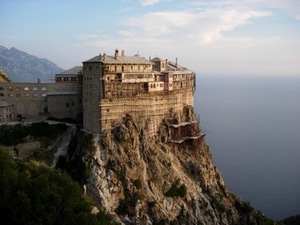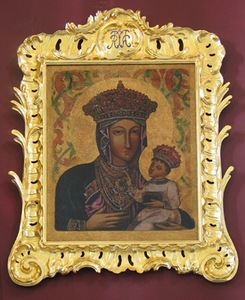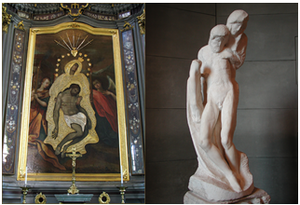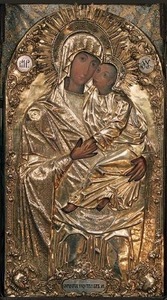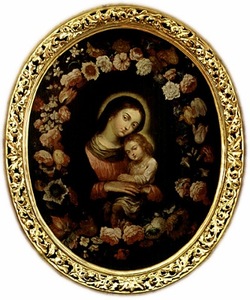Miraculous paintings of Kaunas 6
In brief: The cult of relics of saints and miraculous images makes one suppose that Christianity is not a monotheistic religion completely. People believe in a number of “smaller deities” in addition to the Highest Lord. What is a saint? The miracle of saints was in their bodies, bones, hair, clothing; as a result, these relics were collected and stored in churches, chapels or homes. Miraculous paintings are also special church relics that attracted people not only for their artistic value but also for the miracles related with them or their mysterious appearance.
The biggest number of miraculous paintings (22) may be found in the Monastery of Simonopetra, on the Mount of Aton in Greece. The majority of them were brought here from Constantinople, were repainted and spread in Europe later.
A rather big number of paintings famous for miracles could be found in the Grand Duchy of Lithuania. The most famous paintings of this kind are located in Šiluva, Trakai and Vilnius. Not many people know that there are a few of such paintings with “divine powers” and one Crucifix (moved from the pulled-down Lord Jesus Chapel in E.Ožeškienės Str. to St. Gertrude Church in 1850) in Kaunas too. Four miraculous paintings are present in Kaunas, and the author introduces their history and miracles related with them in the article.
According to the art critic Prof. Laima Šinkūnaitė, the painting of the Blessed Virgin Mary of Grace was the most famous in Kaunas in the 17th -18th century. The painting became famous for its miracles in the 17th century already. It is not known where the painting was from and who was it created by (which is typical of the majority of miraculous paintings). The first mention about it is in the archive of the Bernardine Convent in 1669, and it is listed in the visitation acts of St. George the Martyr Church from the beginning of the 19th century to the middle of the 20th century. Presently it is located at St. George the Martyr Church.
Another equally famous painting may be seen in Kaunas Cathedral. It is a painting of the Mother of Sorrows created by an unknown author surrounded by votive offerings. This piece of art is the oldest in the cathedral (it is believed that it was brought to the church in 1600) and it hangs on the altar of the same title.
The third painting reached Kaunas from Surdegis Holy Spirit Monastery (where it was stored in 1530 – 1915) and is not so well known to Kaunas inhabitants as it is stored in the Orthodox Annunciation Church in Kaunas.
The last painting is known to people of Kaunas the best – it is the painting of the Beautiful Mother of Love with Child known as the Camaldolese Mother of God stored in Pažaislis Monastery, which is also called the Versailles of Kaunas.
This complex of buildings is considered to be one of the most beautiful Baroque masterpieces of Eastern Europe. Funded by the Chancellor of the Grand Duchy of Lithuania Kristupas Zigmantas Pacas (Krzysztof Zygmunt Pac) (1621 - 1684) and his wife Klara Isabella Mailly Lascaris (1631 - 1685), the church of Pažaislis was famous for the miraculous painting of the Blessed Virgin Mary and Child from the old days. The author of the painting is unknown, and the painting became famous for its miracles right after its transportation from Italy.
Thus, the author concludes that the miraculous paintings located in Kaunas may be compared to paintings famous in the world boldly not only for their miracles but also for their mysterious authors.
